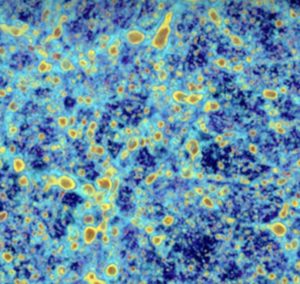
Large-scale structure of the universe resulting from a supercomputer simulation of the evolution of the universe. Credit: Habib et al./Argonne National Lab
Dan Rosplock from Virginia Tech writes that Large-scale simulations could shed light on the ‘dark’ elements that make up most of our cosmos. By reverse engineering the evolution of these elements, they could provide unique insights into more than 14 billion years of cosmic history. If you only account for the matter we can see, our entire galaxy shouldn’t exist. The combined gravitational pull of every known moon, planet, and star should not have been strong enough to produce a system as dense and complex as the Milky Way.
It sounds somewhat incredible, but we’ve done similar things in the past by combining statistical methods with supercomputer simulations, looking at epidemics,” said Dave Higdon, a professor in the Biocomplexity Institute’s Social and Decision Analytics Laboratory and a faculty member in the Department of Statistics, part of the Virginia Tech College of Science.
So what’s held it all together?
Scientists believe there is a large amount of additional matter in the universe that we can’t observe directly – so-called “dark matter.” While it is not known what dark matter is made of, its effects on light and gravity are apparent in the very structure of our galaxy. This, combined with the even more mysterious “dark energy” thought to be speeding up the universe’s expansion, could make up as much as 96 percent of the entire cosmos.
In an ambitious effort directed by Argonne National Laboratory, researchers at the Biocomplexity Institute of Virginia Tech are now attempting to estimate key features of the universe, including its relative distributions of dark matter and dark energy. The U.S. Department of Energy has approved nearly $1 million in funding for the research team, which has been tasked with leveraging large-scale computer simulations and developing new statistical methods to help us better understand these fundamental forces.
To capture the impact of dark matter and dark energy on current and future scientific observations, the research team plans to build on some of the powerful predictive technologies that have been employed by the Biocomplexity Institute to forecast the global spread of diseases like Zika and Ebola. Using observational data from sources like the Dark Energy Survey, scientists will attempt to better understand how these “dark” elements have influenced the evolution of the universe.
Using statistical methods to combine input data on population, movement patterns, and the surrounding terrain with detailed simulations can forecast how health conditions in an area will evolve quite reliably — it will be an interesting test to see how well these same principles perform on a cosmic scale.”
If this effort is successful, results will benefit upcoming cosmological surveys and may shed light on a number of mysteries regarding the makeup and evolution of dark matter and dark energy. What’s more, by reverse engineering the evolution of these elements, they could provide unique insights into more than 14 billion years of cosmic history.
In related news, my good friend Dr. Stephen Perrenod has published a new book entitled Dark Matter, Dark Energy, Dark Gravity:Enabling a Universe that Supports Intelligent Life. Steve is an astrophysicist and a long-time member of the HPC community, so when he asked me to write the Foreword for the book, I jumped at the chance.
Foreword,
by Rich Brueckner“Through our eyes, the universe is perceiving itself. Through our ears, the universe is listening to its harmonies. We are the witnesses through which the universe becomes conscious of its glory, of its magnificence.”
— Alan WattsWe all know of the Big Bang, how our universe came to be in a massive explosion, seemingly starting from nothingness. And for those who study cosmology, further understanding requires us to define the dark energies that somehow endowed our world with order.
Now, we haven’t observed dark energy, dark matter, and the secrets of dark gravity directly, but we do see their effects. As we learn in this book, without them, the universe would not have formed in a way that could have spawned intelligent life.
As a writer, I am intrigued by these dark energies because they imply a backstory–phenomena that happened first that led to this outcome. So in this way, dark energies seem to me to be metaphors of science. Like the stories of Genesis and Adam and Eve, what they really represent is a deeper truth.
In this book, Dr. Perrenod does a wonderful job of explaining the origins of the universe in way that is accessible to the layman. When you want to understand how the universe came to be, you ask an astrophysicist. But when you really want to know why, I think you have to start by asking yourself some questions. Try a thought experiment.
Put yourself in the place of a Universal Mind before the Big Bang. If you really wanted to understand yourself, you would need to have something intelligent outside of yourself that could experience that which is you. Not to get metaphysical here, but if we were at the scene of a crime, what I’d be suggesting here is motive.
Thanks to modern physics and cosmology, we no longer live in a universe where dark forces lurk far beyond our capacity for comprehension. I believe that, through the works of Stephen Perrenod and others, we will come to that knowing. But even as we look out to the stars, I think it begins with understanding that not only are we within the universe, but the universe is within us.
Dark Matter, Dark Energy, Dark Gravity is now available as an ebook on a number of different platforms including the Kindle and Nook, with more on the way. It’s well worth the read, and Dr. Perrenod has now started a blog on related topics in cosmology.




